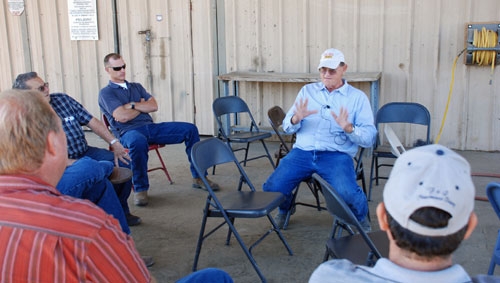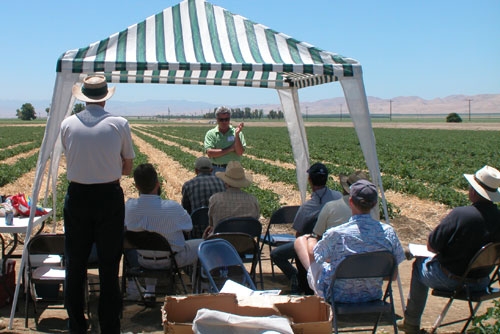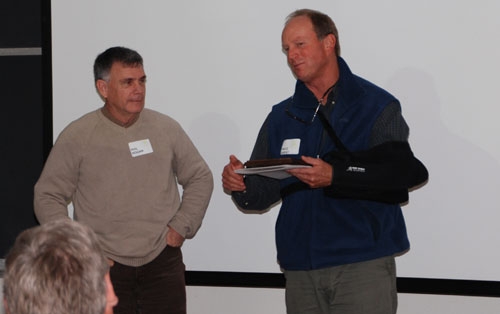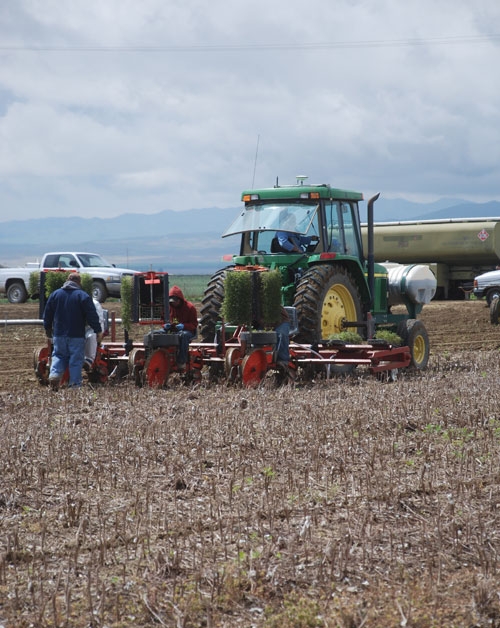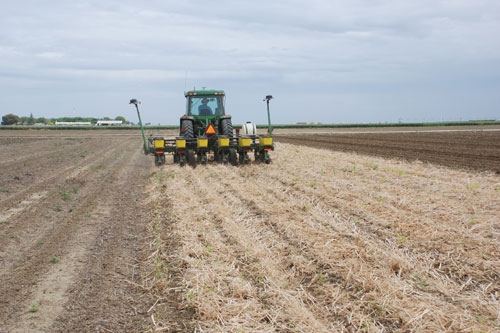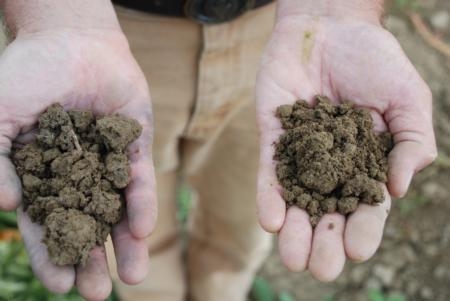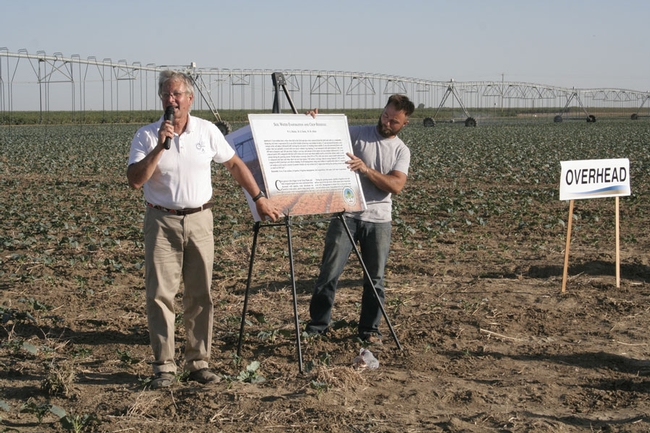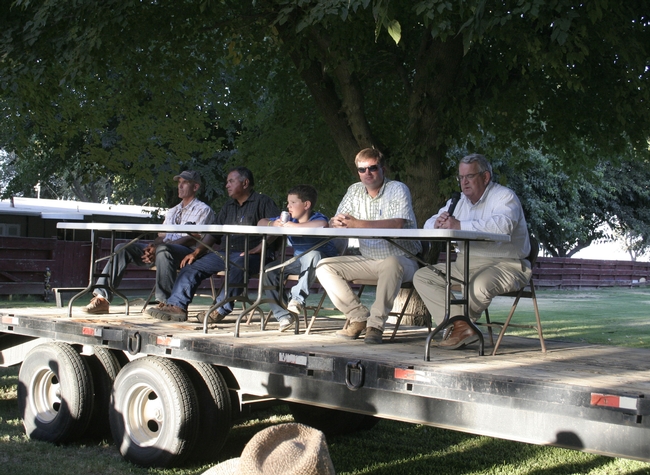Conservation agriculture news
2011 CT farmers awarded
In 2005, the University of California and NRCS Conservation Tillage Workgroup established the Conservation Tillage Farmer Innovator Award as a means for providing greater visibility to CT pioneers in California. The criteria for this award are demonstrated innovation and leadership in the development, refinement and use of conservation tillage systems within the California crop production environment. Nominations are received and carefully reviewed by a workgroup panel and recipients are announced in annual meetings held in both Five Points and Davis.
The recipients of the 2011 CT Farmer Innovator Awards are Michael Crowell of Turlock, Fred Leavitt and Steve Fortner of Firebaugh, and Fritz Durst of Zamora in Yolo County.
The award to Michael Crowell of Bar Vee Dairy acknowledges the outstanding and pioneering work he has done to develop and expand no-till dairy forage production systems at his dairy and also recognizes the very generous contributions he has made to California’s Conservation Cropping Systems Workgroup. Over the past several years, Michael has acquired and mastered tremendous knowledge and experience related to no-till production and he is now a true pioneer of these systems in California. His entire dairy is now completely no-till, including no-till twin row corn, no-till drilled sorghum sudan, followed by no-till wheat or triticale.
Michael began his no-till work very strategically. Recognizing that the edges of his field presented compaction issues, he ripped them before starting his no-till planting systems. He also took part in the 2007 CT Workgroup Tour back to Nebraska, South Dakota, Wyoming and Colorado with his wife, Jonette, and has been a very tenacious and supportive participant and mentor for other California farmers and Workgroup members interested in CT.
The thing that sets Michael apart from others is his sheer persistence and commitment to no-till He is, as he has said, committed to making it work and the successes he has had with it to date bear well for his being able to continue down the no-till path. As he mentioned to a UC Davis student tour group, he “loves the dirt,” and loves working on ways to improve his soils.
The essence of Sun Pacific’s CT system is the use of off-season barley or triticale cover crops, strip-tillage ahead of tomato transplanting, and subsurface drip irrigation. Together, these practices have created an economically viable and resource-conserving system that is simply state-of-the-art. They have hosted several CT Workgroup events at their Firebaugh farm fields and recently, in July of 2010, took three tomato farmers from up in the Tracy, Calif., area on a full tour of Sun Pacific’s fields.
Steve and Fred were THE original pioneers in terms of trying the strip-till cover crop tomato system. Their actual first efforts with this system occurred in a small section of one of their Firebaugh fresh market tomato fields back in 2003. This initial attempt was a very bold initiative on their part and it involved considerable planning, careful observation and trouble shooting. They worked on refining the basic strip-tiller and were the first in California to attempt to use a rotary tiller model that they fabricated themselves. They then were also the first to use a ground-driver “Yetter” strip-tiller at their farm.
Their tomato fields are not only typically quite immaculate, but also extremely productive.
Fritz is truly a conservation tillage pioneer in an area of the State that in the early 1980’s was subject to massive sheet and rill erosion that resulted from conventional tillage practices that relied on moldboard plowing and left little or no residues to protect the soil from the impacts of rain.
Fritz has always enjoyed the challenges of agriculture and began accompanying his father around their ranchland and fields by age five. Not long after graduating from UC Davis with a degree in agricultural economics, Fritz and his father turned their attention toward the problem of persistent soil erosion occurring on the uplands of the Capay Hills and the foothills near Dunnigan. They investigated no-till techniques for their small grain crops that involved planting directly into the residue of the previous crop.
The most immediate benefit Fritz realized was a significant reduction in soil erosion. In 1985, after one year of no-till wheat production Durst reported a reduction in annual soil loss from six tons/acre using conventional tillage to two tons/acre in his no-till fields. Additionally, the large six foot deep gullies that appeared after winter storms were not seen the year following their change to no-till and he also has been quoted as not having seen one erosion gully in his wheat and barley fields since he quit tilling the soil. During the next few years, Fritz reported on his experiences at several no-till workshops, and received the RCD “Cooperator of the Year Award” in 1986 for being a pioneer of no-till cultivation in Yolo County.
Awards to Crowell, Fortner and Leavitt were presented at the Workgroup’s Twilight CT and Overhead Irrigation event on Sept. 8 in Five Points and Durst was recognized at a meeting in Davis on Dec. 16. The pioneering accomplishments of each of these innovators make them quite fitting recipients of this year’s CT Farmer Innovator Awards.
More information and photos are available from Jeff Mitchell at mitchell@uckac.edu or (559) 303-9689.
Record no-till yields achieved in 2011
“The bar has been set,” said UC Cooperative Extension vegetable crops specialist Jeff Mitchell. “After toiling for more than a decade, we’ve finally succeeded in putting the pieces together this past season.”
Researchers harvested 3.4 bales per acre of cotton and 53 tons per acre of processing tomatoes using no-till techniques. Plots managed with conventional tillage practices averaged about 3.4 bales per acre for cotton and 49 tons per acre for tomatoes.
The research was conducted at the UC West Side Research and Extension Center near Five Points, Calif. Scientists established the cotton crop by direct seeding into beds that had not been touched since the preceding tomato crop, except by two herbicide sprays. The 2011 tomato crop was established with a no-till transplanter following the 2010 cotton crop, which had only been shredded and root-pulled under a waiver granted by CDFA’s Pink Bollworm Eradication Program.
The 2011 regime represented the first time since the start of the study in 1999 that the Five Points research team strictly followed no-tillage techniques for both crops. In past years, in which tomato yields reached the mid-60 tons per acre, in-season cultivation for weed control was used. In 2011, however, the goal of going completely no-till was realized in preparation for 2012, when the field will be converted to subsurface drip irrigation for all subsequent no-till plantings. Scientists believe the 2011 tomato harvest for both conventional and no-till plots was lower than in previous years because planting took place April 7 due to weather and scheduling delays.
UC Cooperative Extension agricultural economist Karen Klonsky estimates that switching to no-till production reduced expenditures by about $135 per acre for the tomato crop and about $40 per acre for cotton.
“What we’re trying to do in this research,” Mitchell said, “is to look far into the future and evaluate the true costs and benefits of these alternative systems. Producers, as well as the general public, can then better understand broad future benefits and goals for sustainable crop and resource management, allowing farmers to develop and eventually adopt production practices that might best reach these goals.”
Future goals for conservation tillage production systems include profitability, resource quality, conservation, as well as broader ecosystem services.
“No-till makes sense as a means for lowering production costs and cutting dust and greenhouse gas emissions,” Mitchell said. “No-till also improves soil functions, such as increased carbon storage, greater stability of soil aggregates, increased porosity and water infiltration, and a larger population of earthworms.”
The benefits of no-till farming have been recognized by researchers and farmers in other regions, such as the Great Plains and the Pacific Northwest regions of the U.S., across much of Canada, and also throughout large areas of South America.
“These benefits start to pile up pretty fast once longer-term and broader sustainability goals are factored in,” Mitchell said.
Mitchell and his Five Points team are part of California’s Conservation Agriculture Systems Institute (CASI), a diverse group of more than 1,500 farmers, industry representatives, university, Natural Resource Conservation Service and other public agency members. Over the past 10 years, the team has come together to develop information on the true costs and benefits of the production system and irrigation management alternatives and to help develop appropriate sustainability goals for the long haul.
“One of the things that CASI does is track changes in tillage management practices that are used throughout the San Joaquin Valley,” said long-time member and former air quality coordinator for the California Association of Resource Conservation Districts Ron Harben. “Our most recent survey for 2010 showed an increase of about 5 percent in no-till and strip-till acreage over previous years. As of 2010, over 47 percent of the cropland in the San Joaquin Valley is using some form of conservation tillage.”
Tillage practices changing
California’s Conservation Agriculture Systems Institute (CASI) has prepared its survey of tillage management acreage for 2010. This tillage survey was conducted as an ongoing comparison of annual row crop acreage that is farmed under different tillage systems throughout the Central Valley region of California. Over 35 local NRCS, University of California and private sector experts were surveyed and results were compared with 2010 county agricultural commissioner cropland acreage. Previous surveys have been conducted in 2004, 2006 and 2008.
Data in this survey were compiled for two general types of conservation tillage. Tillage practices such as no-till, strip-till, ridge-till and mulch-till, that leave at least 30 percent of the residue from previous crops in place on the soil surface are the typical forms of conservation tillage that are recognized throughout the world. In addition to these practices, “minimum tillage” practices that reduce the overall number of tillage passes by at least 40 percent relative to what was done in 2000, are also included in the institutes’s tally of conservation tillage acreage.
In 2010, conservation tillage systems accounted for about 14 percent of the acreage for the crops that were surveyed including silage and grain corn, small grains for hay, silage and grain, tomatoes, cotton, dry beans, and melons throughout the nine-county Central Valley region. This was an increase from about 10 percent in 2008. Minimum tillage practices were used on about 33 percent of crop acreage in 2010, also up from about 21 percent in 2008.
The largest change in conservation tillage acreage over the 2004–2010 period is found in the amount of corn silage acreage that uses strip-tillage. In 2004, there were only about 490 acres of summer silage corn using strip-till, while in 2010 more than 103,000 acres throughout the San Joaquin Valley dairy region had adopted the use of this form of conservation tillage. The overall use of minimum tillage practices has also greatly increased during this time from about 64,000 acres under reduced pass tillage in 2004 and just over 700,000 acres under minimum tillage in 2010.
|
California conservation tillage acreage survey (2010) for tomatoes, cotton, edible dry beans, silage corn, grain corn, and small grains for grain, hay and silage, December 15, 2011 |
||||||||
|
|
> 30% Residue Cover after Planting |
|
|
|
>40% reduction in total passes |
< 30% Residue Cover after Planting |
Total Acreage |
CT % |
|
Total |
No Till |
RT/ST |
Mulch Till |
CT Total |
Minimum Tillage |
Conventional Tillage |
||
|
Fresno County |
- |
1,280 |
3,331 |
4,611 |
148,800 |
389,688 |
394,299 |
1% |
|
Kern County |
- |
- |
711 |
711 |
- |
220,504 |
221,215 |
0% |
|
Kings County |
3,037 |
54,498 |
32,154 |
89,689 |
44,156 |
228,157 |
317,846 |
28% |
|
Madera County |
100 |
14,909 |
- |
15,009 |
- |
46,511 |
61,520 |
24% |
|
Merced County |
3,000 |
18,100 |
19,866 |
40,966 |
- |
227,928 |
268,894 |
15% |
|
Sacramento |
620 |
559 |
1,866 |
3,045 |
3,568 |
46,913 |
49,958 |
6% |
|
San Joaquin |
2,100 |
- |
- |
2,100 |
150,260 |
276,440 |
278,540 |
1% |
|
Tulare County |
- |
68,478 |
12,270 |
80,748 |
305,184 |
340,382 |
421,130 |
19% |
|
Yolo County |
23,530 |
- |
26,069 |
49,599 |
49,792 |
47,295 |
96,894 |
51% |
|
Total |
32,387 |
157,824 |
96,267 |
286,478 |
701,760 |
1,823,818 |
2,110,296 |
|
For additional information and photos of various forms of conservation tillage, please contact Jeff Mitchell at (559) 303-9689 or mitchell@uckac.edu .
The body of CT research knowledge continues to grow
UC scientists presented recent additions to the growing body of research on conservation tillage in California at the second annual Twilight Conservation Tillage and Cropping Systems field day Sept. 8, demonstrating progress in agricultural systems that will help farmers cut production costs, reduce soil disturbance and save water.
UC scientists and their partner farmers are conducting research that address the current needs of the San Joaquin Valley agricultural industry and research that is looking to the future by anticipating changes that may need to be negotiated in coming decades.
During the field day at UC's West Side Research and Extension Center in Five Points, Calif., participants visited two primary research areas. The first is the longest-standing conservation ag system study in California, where a cotton/tomato rotation has been farmed for 12 years running. The plots include standard tillage with and without cover crops and conservation tillage with and without cover crops.
“This might be the most-visited research field in California,” said Jeff Mitchell, UC Cooperative Extension vegetable crops specialist and chair of the CT workgroup. “Many students and scientists have conducted research here.”
For example, scientists have been able to quantify significant improvements in soil quality with the use of cover crops and conservation tillage. UC Davis soil biochemist Will Horwath reported that conservation tillage combined with an off-season cover crop has increased the soil carbon content close to five tons per hectare.
“Is that significant?” Horwath asks. “Yes. In 10 years, we have almost doubled the soil carbon content.”
Because of the valley’s dry, hot climate, the native soils are typically very low in carbon, which is a characteristic of low soil quality. Carbon in the soil acts as a glue, helping reduce wind erosion.
At the second research field, conservation tillage research is being combined with overhead and subsurface drip irrigation. Coupling overhead irrigation with conservation tillage is common in other regions of the U.S., but is just beginning to get attention in California.
“There are more than 17,000 center pivots in the state of Nebraska, and it is estimated that there are somewhere between 300 and 500 pivots currently in use in California, the No. 1 ag state in the nation,” Mitchell said. “This situation is changing rapidly.”
Overhead irrigation is efficient, automated, allows for diverse cropping and, with soil residues from conservation tillage, permits uniform infiltration.
Four users of overhead irrigation shared their experiences with overhead irrigation at the field day. West side farmer John Deiner said mechanized irrigation has significantly reduced labor input in his agronomic crops while boosting crop yields.
“Our corn grew two to three feet taller under the pivot,” he said.
Will Taylor of King City grows potatoes for In and Out Burger under center pivots. He said his yields are 20 percent higher when using the overhead irrigation system.
“Once you overcome challenges,” Taylor said, “they’re awesome.”
He demonstrated their ease of use by bringing along his 9-year-old son Liam, whom he said can already manage the machine.
Darryl Cordova of Denair uses overhead irrigation in a hilly area on the east side of the valley.
“What used to take three guys six hours of moving pipe is now done with a push of a button on my cell phone,” Cordova said.
Scott Schmidt, who farms across the street from the West Side Research and Extension Center, said he has learned how to successfully use overhead irrigation and conservation tillage from the “school of hard knocks.”
“Most of the problems have been self-inflicted wounds,” Schmidt said. But now, he calls the system “flawless.” “We have seven pivots that I operate remotely from my phone.”
Tony Turkovich featured in UC research video
The 2007 recipient of the Conservation Tillage Innovator of the Year Award, Tony Turkovich, was featured in a recent research video by the UC Office of the President.
See the video here:
TillageVideo 26059

